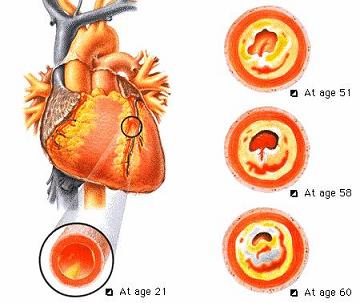Effects of atherosclerosis result from the decreased flow of blood through the diseased arteries. Tissues nourished by these arteries do not receive enough oxygen. A decrease in the blood supply to the brain can cause dizziness, numbness, slurred speech, and other symptoms. In the heart, decreased blood supply can produce severe chest pain called angina pectoris. The complete blockage of an artery supplying the heart or the brain results in a heart attack or a stroke, respectively. A reduced flow of blood to the kidneys may cause hypertension or kidney damage. In the legs, it may cause pain while walking, skin sores, or gangrene (death of tissue).
Prevention and treatment. Most physicians believe that many cases of atherosclerosis can be prevented by reducing exposure to risk factors. Therefore, doctors advise people to avoid cigarette smoking, to reduce if overweight, and to exercise regularly. Detection and control of hypertension and diabetes mellitus are especially important. Many physicians also recommend a diet low in cholesterol and saturated fats.
Treatment of atherosclerosis, like prevention, centers on reducing risk factors. Some patients also get drugs that lower the blood levels of cholesterol. If a major artery becomes obstructed, surgery may be needed. In severe cases, diseased arteries may be replaced or by-passed by grafts of natural or artificial vessels. Another technique, called angioplasty, involves threading a balloon-tipped catheter (slender tube) into the blocked artery. The balloon is then inflated, flattening the blockage against the artery wall.
Toby R. Engel, M.D., Professor of Medicine, University of Texas. -
|


